“In 2015, his strikeout rate ticked up, his BABIP dipped lower than it had been in half a decade, he walked as rarely as ever and — well, we’ve pretty much named all the parts of baseball. (He’s a bad baserunner, too. Okay, now we’ve named ‘em all.)”
This quote is a portion of Melky Cabrera’s player comment in the 2016 iteration of the Baseball Prospectus annual. It’s not pretty, but then again, neither was any of the production that the White Sox saw out of Cabrera in 2015.
Cabrera was walking at just a 5.9 percent clip last season, second lowest of his career, striking out 12.9 percent of the time, the second highest of his career, and his final line on the season was .273/.314/.394 paired with sub-par defense in left field. Of all the unfortunate mishaps that the White Sox had encountered with their new player acquisitions in 2015, at the tune of three years and $42 million — Cabrera was my least favorite to endure.
So now that the White Sox are six weeks into a stellar 2016 campaign start and Cabrera holds the team’s second highest batting average and on-base percentage, just underneath the team’s firecracker lead-off man Adam Eaton, it’ll likely serve as a bit of a shock to most of you (and myself).
Cabrera is one of the best hitters on this team right now, one short year after I thought that the White Sox were going to have to try and sweep a three-year bust under the carpet, and one that came at the expense of Rick Hahn having to come to Jerry Reinsdorf with his hat in his hand to be able to complete. (If you remember the heartwarming tale that the spectacular run the White Sox had at Winter Meetings 2015 boosted season ticket sales, thus justifying the money spent on Cabrera.)
It’s no secret that this season the White Sox have tailored their plate approach for the better across the entire team. They’re currently third in the AL in walk rate, while seventh in strikeout rate.
Right now, Cabrera is walking at a 10.1 percent rate, something he hasn’t done since 2006 with the Yankees when he earned free passes at a 10.7 percent clip. Cabrera has also lowered his strikeout rate from 12.9 percent in 2015 to just 8.9 percent — a feat he’s never accomplished in his career (his strikeout rate has never gone below than 10 percent). So what’s Cabrera doing so differently?
First of all, let me clear the slate by saying that this isn’t really a flukey baseball thing. Whatever the White Sox are doing to help this team improve their discipline at the dish is working, but it’s not turning Cabrera into the hitter the White Sox are seeing, it’s simply enhancing the hitter the White Sox already knew was there. Cabrera has always been a quality bat, and though he’s about to turn 32 in just a few months and scuffled with a back tumor in 2013 that made his numbers less than acceptable, it’s still not a shock to see the type production we’re seeing out of him.
Though Cabrera has claimed that he hasn’t changed his approach at the plate in 2016, it’s worth noting that while his on-base percentage (.371) has gone up due to walks, we can infer from the fact that we’ve seen a dip in his slugging percentage (.413 with only two home runs) coupled with this increase in OBP, that perhaps Cabrera is beginning to sacrifice some of his power stroke in order to be able to get on base a bit more. The rise Cabrera has seen in his BABIP this year also supports this theory: Cabrera’s BABIP is currently .323, which is more in line with his BABIP of the last several seasons than his .297 rate was in 2015.
Cabrera is also carefully choosing what pitches to hit this season, check out his contact rates from 2016 compared to 2015:
| Swing% | O-Contact% | Z-Contact% | Contact% | |
| 2015 | 46.8 | 80.2 | 92.7 | 88.1 |
| 2016 | 43.9 | 83.2 | 94 | 89.6 |
Some of these are small increments, but considering what we’re seeing from Cabrera, it seems to be a refined approach, the gap between the numbers is likely to widen if he truly has gotten a better eye at the plate and is choosing his pitches with caution.
“I’ve just been working hard, and that’s basically my key. I’m trying to see the ball, see a good pitch to hit and put the bat on the ball.” Cabrera told the Tribune’s Colleen Kane in Texas.
Now, take a look at these maps of Cabrera’s batting average in two and three ball counts. If patience at the plate was a picture, it would look like this.
One of the biggest struggles that Cabrera seems to face is his trouble with pitches that generate a lot of movement. But even these offerings haven’t been much of a problem this year — I just suppose I was looking for one large flaw in Cabrera’s approach and came away with a small gripe instead. Cabrera has met the most trouble with cutters, curveballs, and sliders, check out his whiffs per swing on these three pitches in 2016.
Cabrera’s issue isn’t that he’s whiffing on these pitches too often, as the maps show, it’s just simply that he’s not making meaningful contact on them, or he ends up taking many of them for strikes in the zone. (Specifically the breaking pitches, as Cabrera is taking 38 percent of cutters for strikes in 2016.)
Check out his batting average vs. groundball maps on these three offerings.
This could end up becoming a slight issue for Cabrera, as in May, he’s seen a bit of drastic uptick in the number of breaking pitches he’s seeing:
The thing about Cabrera’s recent success is it’s very simple, he’s cut back on his swings, therefore lowering his strikeouts, he’s carefully choosing what pitches to swing at and when to swing at them, and he’s making good contact on them when he does. Manager Robin Ventura has even referred to Cabrera this season as the most consistent guy in this White Sox lineup, and his plain-but-effective approach is a large contributor to that.
The thing about a good approach is it’s a solid foundation for success. If Cabrera was randomly clubbing the bat at pitches that just happen to be in missed spots leading to successful numbers in the first six weeks of the season, I’d have to say that was likely unsustainable and that the joy ride would end fairly soon. But if Cabrera continues to have as keen of an eye as he has had early on, he very well may continue to be the most consistent guy in this lineup throughout 2016.
Lead photo courtesy of Kim Klement-USA TODAY Sports
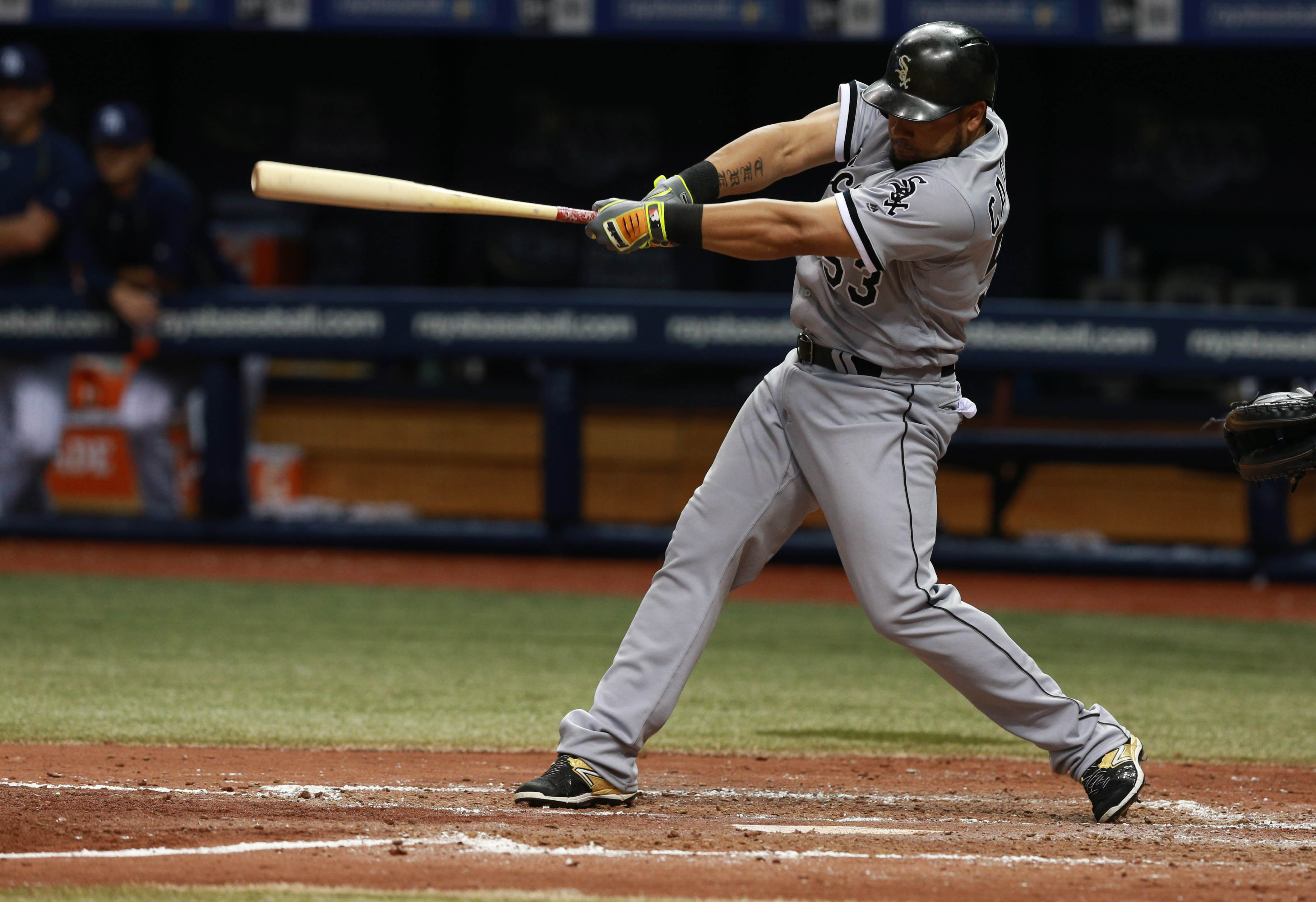
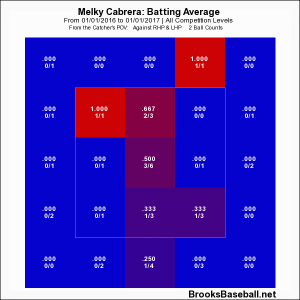
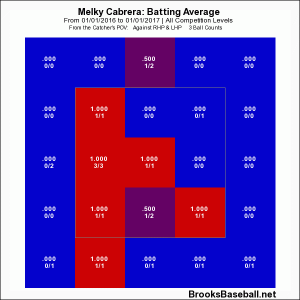
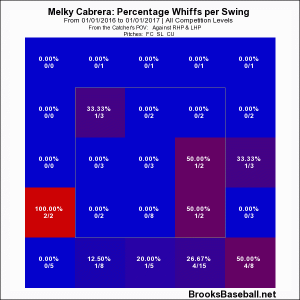
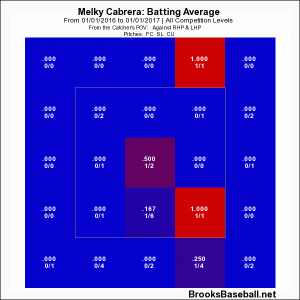
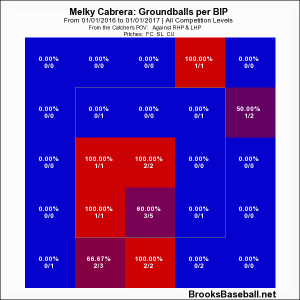
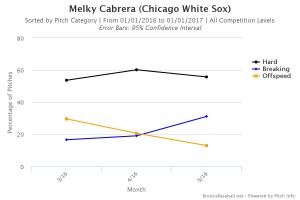
we need him to do exactly what he’s doing – get on base. it’s then up to abreu and frazier to do the damage.